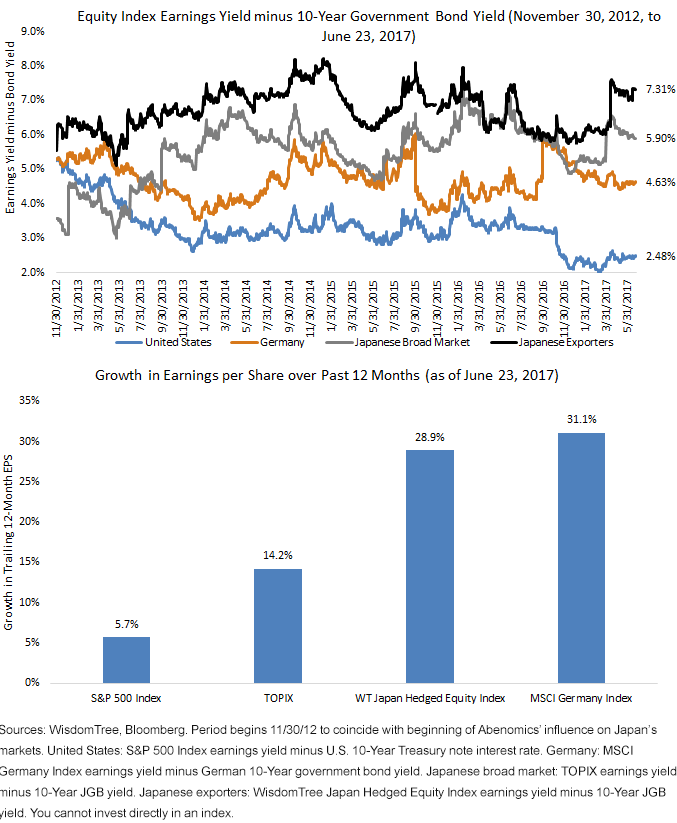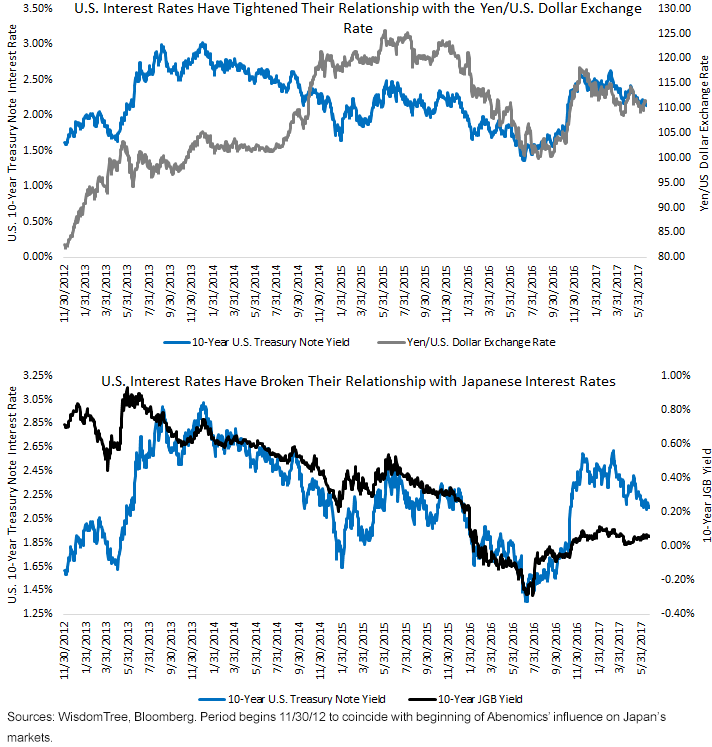The BOJ Is Telling Us to Buy Japanese Equities. Should You Listen?


At WisdomTree, we track a very interesting weekly statistic reported by Japan’s Ministry of Finance (MOF)—the net flows from foreign investors into Japan’s equity market.1
As of June 16, 2017, approximately $2.7 billion had gone INTO Japan’s equities for the 2017 year-to-date period. That compares to $155 billion in 2013, $22.5 billion in 2014, $3.5 billion in 2015 and nearly $40 billion OUT in 2016.2
In short, the year-to-date data indicated a reversal from a very large outflow year (2016), but still negligible interest in Japanese stocks from foreign investors.
The Disconnect: Investor Activity vs. Central Bank Policy
We, like most other global investors, have seen the phenomenal run that U.S. equities3 have enjoyed since recovering from the 2008–09 global financial crisis. In our discussions, one of the universally accepted contributing factors was the responsiveness of the U.S. Federal Reserve (Fed) in its monetary policy.
Today, the Fed has begun a policy “normalization” process and is contemplating reducing its balance sheet.
Japan represents a market where not only is there policy support to keep rates low, but the central bank is buying equities directly to support the markets and reduce risk premiums for investors.4
Valuation & Earnings Growth Present a Strong Combination

One of the most interesting manifestations of the Bank of Japan’s policy becomes visible when considering the relative valuation of Japanese government bonds (JGBs) versus equities. A classic methodology would be the Fed Model, comparing equity earnings yields to 10-Year government bond yields. The key: high earnings yields (low price-to-earnings (P/E) ratios is another way to say this) and low 10-Year government bond yields.5
- Even though 10-Year Treasury note interest rates are still historically low, the U.S. has seen earnings yields dropping due to very strong equity performance. Equities have therefore become more expensive compared to bonds. Whereas five years ago, the U.S. earnings yield was more than 5 percentage points higher than bond yields, today it has fallen to half those levels.6
- The German 10-Year government bond—shown to represent the largest market in the eurozone—is also historically low in terms of its yield, with the European Central Bank (ECB) continuing its bond-buying program at least for now. The spread between German equities (MSCI Germany Index) and German bonds is 2 percentage points higher than the U.S. and just a touch lower than where it was five years ago. Notably, five years ago, Germany was at the same spread as the U.S., so perhaps this too represents an opportunity on relative value.7
- In terms of this depiction of the Fed Model, Japanese equities clearly stand out. Here we show two versions—one focused on the broad Japanese equity market (TOPIX) and one focused on exporters (the WisdomTree Japan Hedged Equity Index). Both look attractive compared to the U.S. and Germany, but with a yen that’s closer to 110 than 120 against the U.S. dollar, as well as geopolitical rumblings, Japan’s exporters have the least expensive relative valuation.
Earnings growth allows us to take a step beyond simply measuring the valuation of equities versus bonds, taking stock of a different indicator of company fundamentals. Over the past 12 months, it’s clear that Japanese exporters and German equities have been strong, compared to Japan’s broad market and the United States.
If U.S. Interest Rates Cooperate, the Yen Can Unlock Japan’s Equity Opportunity

Another great visual depiction of the BOJ’s impact on markets is the shift from a high correlation between movements in Japan and U.S. 10-Year government interest rates to a high correlation between movements in U.S. 10-Year government interest rates and the yen/dollar exchange rate.
Since the September 21, 2016, shift in BOJ policy to cap its long-bond rate near zero,8 rising interest rates in the U.S. have led to a weaker yen (and vice versa for falling interest rates in the U.S.). Effectively, the BOJ has broken the correlation between the Japanese 10-Year interest rate and that of the U.S., forcing the U.S. interest rate moves to show up in movement of the yen.
A Few Questions to Conclude
If we put U.S. equities, German equities, Japanese equities and Japanese exporters side by side over the last year, which performed the best? The interesting answer: Japanese exporters, even though we just saw that they have the least expensive relative valuation. Certainly a risk scenario to Japan is the U.S. 10-year drifting down, which could cause the yen to rise back toward 100. But with a view that U.S. rates will head higher with the unwinding of the Fed’s balance sheet, Japan is an unloved recipient of global flows in the last 18 months and has a market that is seeing improved fundamental strength and attractive relative prices. We’d advocate global investors re-engage with Japan.
1Source: “The Foreign Securities Investment into Japan Stocks Net Flows Year-to-Date (YTD),” reported weekly by the Ministry of Finance, accessed through Bloomberg.
2Source: Bloomberg. YTD 2017 is from 12/31/16 to 6/16/17. Comparisons shown from 2013 onward to indicate the period after the election of Prime Minister Shinzo Abe and the Abenomics period in Japan.
3Refers to the S&P 500 Index.
4As of the 9/21/16 implementation of its current policy of yield curve control, BOJ had also committed to continuing its purchase of equity market ETFs at a rate of approx. 6 trillion yen per year.
6As of 11/30/12, the earnings yield of the MSCI Germany Index minus the 10-Year German government bond yield was 5.30%. As of 6/23/17, this value was 4.63%.
7As of 11/30/12, the earnings yield of the MSCI Germany Index minus the 10-Year German government bond yield was 5.30%. As of 6/23/17, this value was 4.63%.
8Source: “New Framework for Strengthening Monetary Easing: ‘Quantitative and Qualitative Monetary Easing with Yield Curve Control,’” Bank of Japan, 9/21/16.
Important Risks Related to this Article
Investments focused in Japan increase the impact of events and developments associated with the region, which can adversely affect performance.
Christopher Gannatti began at WisdomTree as a Research Analyst in December 2010, working directly with Jeremy Schwartz, CFA®, Director of Research. In January of 2014, he was promoted to Associate Director of Research where he was responsible to lead different groups of analysts and strategists within the broader Research team at WisdomTree. In February of 2018, Christopher was promoted to Head of Research, Europe, where he was based out of WisdomTree’s London office and was responsible for the full WisdomTree research effort within the European market, as well as supporting the UCITs platform globally. In November 2021, Christopher was promoted to Global Head of Research, now responsible for numerous communications on investment strategy globally, particularly in the thematic equity space. Christopher came to WisdomTree from Lord Abbett, where he worked for four and a half years as a Regional Consultant. He received his MBA in Quantitative Finance, Accounting, and Economics from NYU’s Stern School of Business in 2010, and he received his bachelor’s degree from Colgate University in Economics in 2006. Christopher is a holder of the Chartered Financial Analyst Designation.

